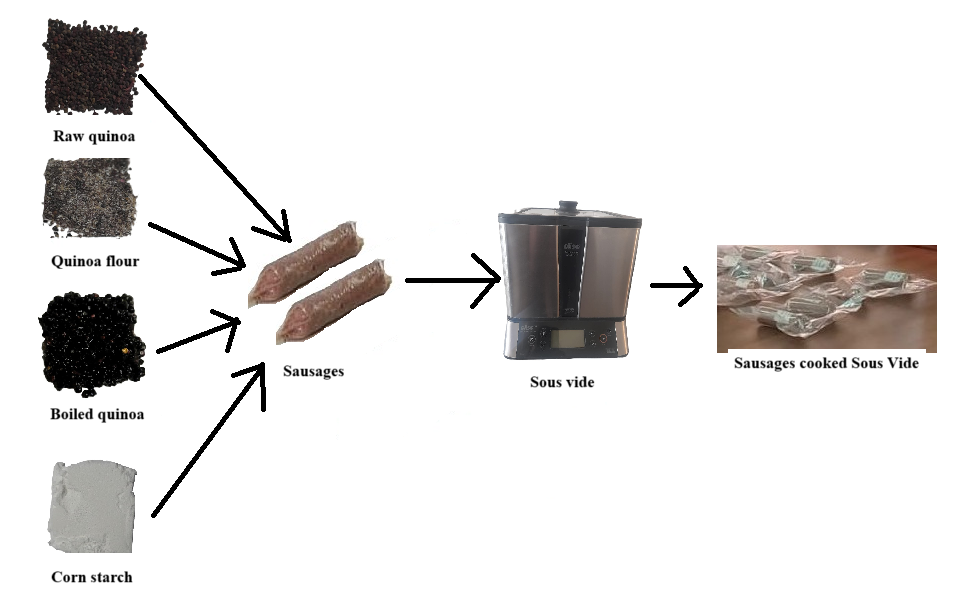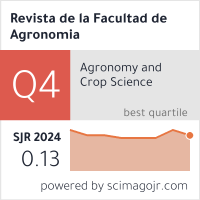Capacidad antioxidante y oxidación lipídica de salchichas de alpaca con quinua roja cocidas por Sous Vide
Resumen
Actualmente el consumo de salchichas se ha relacionado con problemas de salud, debido a su alto contenido de ácidos grasos y colesterol, obligando al uso de carnes con bajo contenido de grasa, uso de antioxidantes naturales, extensores, además de nuevas tecnologías de procesamiento, para mantener sus propiedades nutricionales y disminuir su oxidación. El objeto de este trabajo fue evaluar el efecto de la quinua roja como extensor sobre la capacidad antioxidante y la oxidación lipídica en salchichas de alpaca cocidas a diferentes temperaturas por Sous Vide. Para el estudio, se elaboraron salchichas de alpaca, mezclando carne molida de alpaca, sal, grasa animal y extensores (quinua cruda, harina de quinua, quinua cocida y almidón de maíz). Las mezclas fueron cocidas en Sous Vide a 60 y 80 °C, y se almacenaron a 50 °C durante 12 días, tomando muestras los días 1, 7 y 12, para la determinación de la capacidad antioxidante (método de ABTS), la oxidación lipídica (método TBARS), pH, color y textura. Los resultados indicaron que los mayores valores de la capacidad antioxidante se obtuvieron en las salchichas de alpaca con harina de quinua, provocando menor grado de oxidación lipídica, indicado por el bajo valor de TBARS, además, por la mayor estabilidad en los valores de pH, luminosidad (L*), enrojecimiento (a*) y menor decoloración (b*), pudiendo atribuirse a los antioxidantes fenólicos de la quinua roja. En conclusión, el uso de quinua roja, es una alternativa porque, no solo puede ser un extensor en la elaboración de salchichas, sino porque, inhibe la oxidación lipídica y mejora la actividad antioxidante del producto.
Descargas
Citas
Çelebi, U., & Erge, A. (2024). An approach to produce healthier meat products: Effect of k-carrageenan and inulin on quality characteristics of bologna-type chicken sausages. International Journal of Gastronomy and Food Science, 36, 100907. https://doi.org/10.1016/j.ijgfs.2024.100907
Choe, J.-H., Kim, H.-Y., Lee, J.-M., Kim, Y.-J., & Kim, C.-J. (2013). Quality of frankfurter-type sausages with added pig skin and wheat fiber mixture as fat replacers. Meat Science, 93(4), 849-854. https://doi.org/10.1016/j.meatsci.2012.11.054
Cruz-Tirado, J. P., Vieira, M. S. dos S., Correa, O. O. V., Delgado, D. R., Angulo-Tisoc, J. M., Barbin, D. F., & Siche, R. (2024). Detection of adulteration of Alpaca (Vicugna pacos) meat using a portable NIR spectrometer and NIR-hyperspectral imaging. Journal of Food Composition and Analysis, 126, 105901. https://doi.org/10.1016/j.jfca.2023.105901
Deepitha, R. P., Xavier, K. A. M., Layana, P., Nayak, B. B., & Balange, A. K. (2021). Quality improvement of pangasius fillets using aqueous seaweed (Padina tetrastromatica) extract. LWT, 137, 110418. https://doi.org/10.1016/j.lwt.2020.110418
Deng, N., Liu, Y., Cai, Y., Li, H., Li, C., Xiao, Z., Zhang, B., Liu, M., Fang, F., & Wang, J. (2024). Characterization, antioxidant, and sausage preservation effects of ethanol extract from lotus seed peel powder. Food Control, 158, 110202. https://doi.org/10.1016/j.foodcont.2023.110202
Fernández-López, J., Lucas-González, R., Viuda-Martos, M., Sayas-Barberá, E., Ballester-Sánchez, J., Haros, C. M., Martínez-Mayoral, A., & Pérez-Álvarez, J. A. (2020). Chemical and technological properties of bologna-type sausages with added black quinoa wet-milling coproducts as binder replacer. Food Chemistry, 310, 125936. https://doi.org/10.1016/j.foodchem.2019.125936
Huang, Q., Xiong, K., Wang, Y., Xiong, Z., Lu, H., Peng, L., Jin, W., Wang, W., Ni, L., & Wang, H. (2025). Physical and flavor characteristics of reduced sodium sausages containing plant proteins and blends of chloride salts. LWT, 215, 117268. https://doi.org/10.1016/j.lwt.2024.117268
Kasaiyan, S. A., Caro, I., Ramos, D. D., Salvá, B. K., Carhuallanqui, A., Dehnavi, M., & Mateo, J. (2023). Effects of the use of raw or cooked chickpeas and the sausage cooking time on the quality of a lamb-meat, olive-oil emulsion-type sausage. Meat Science, 202, 109217. https://doi.org/10.1016/j.meatsci.2023.109217
Lang, M. (2020). Consumer acceptance of blending plant-based ingredients into traditional meat-based foods: Evidence from the meat-mushroom blend. Food Quality and Preference, 79, 103758. https://doi.org/10.1016/j.foodqual.2019.103758
Li, C., Xie, W., Zhang, X., Liu, J., Zhang, M., & Shao, J. (2023). Pickering emulsion stabilized by modified pea protein-chitosan composite particles as a new fat substitute improves the quality of pork sausages. Meat Science, 197, 109086. https://doi.org/10.1016/j.meatsci.2022.109086
Luan, X., Feng, M., & Sun, J. (2021). Efecto de Lactobacillus plantarum sobre la actividad antioxidante en embutidos fermentados. Food Research International, 144, 110351. https://doi.org/10.1016/j.foodres.2021.110351
Ma, Q., Li, Z., Kumrungsee, T., Huang, W., & Cao, R. (2023). Effect of pressure cooking on phenolic compounds of quinoa. Grain & Oil Science and Technology, 6(3), 127-134. https://doi.org/10.1016/j.gaost.2023.03.001
Manzoor, A., Ahmad, S., & Yousuf, B. (2022). Effect of bioactive-rich mango peel extract on physicochemical, antioxidant and functional characteristics of chicken sausage. Applied Food Research, 2(2), 100183. https://doi.org/10.1016/j.afres.2022.100183
Monteiro, G. M., Souza, X. R., Costa, D. P. B., Faria, P. B., & Vicente, J. (2017). Partial substitution of pork fat with canola oil in Toscana sausage. Innovative Food Science & Emerging Technologies, 44, 2-8. https://doi.org/10.1016/j.ifset.2017.07.013
Muchekeza, J. T., Jombo, T. Z., Magogo, C., Mugari, A., Manjeru, P., & Manhokwe, S. (2021). Proximate, physico-chemical, functional and sensory properties OF quinoa and amaranth flour AS potential binders in beef sausages. Food Chemistry, 365, 130619. https://doi.org/10.1016/j.foodchem.2021.130619
Naqvi, Z. B., Campbell, M. A., Latif, S., Thomson, P. C., Astruc, T., Friend, M. A., Vaskoska, R., & Warner, R. D. (2022). The effect of extended refrigerated storage on the physicochemical, structural, and microbial quality of sous vide cooked biceps femoris treated with ginger powder (zingibain). Meat Science, 186, 108729. https://doi.org/10.1016/j.meatsci.2021.108729
Nyaguthii, K. C., Omwamba, M., & Nduko, J. M. (2023). Gum arabic and soy protein concentrate as binding agents on quality and nutritional properties of mushroom-based sausage analogues. Food and Humanity, 1, 1627-1636. https://doi.org/10.1016/j.foohum.2023.11.010
Owusu-Ansah, P., Besiwah, E. K., Bonah, E., & Amagloh, F. K. (2022). Non-meat ingredients in meat products: A scoping review. Applied Food Research, 2(1), 100044. https://doi.org/10.1016/j.afres.2022.100044
Pintado, T., & Delgado-Pando, G. (2020). Towards More Sustainable Meat Products: Extenders as a Way of Reducing Meat Content. Foods, 9(8), Article 8. https://doi.org/10.3390/foods9081044
Re, R., Pellegrini, N., Proteggente, A., Pannala, A., Yang, M., & Rice-Evans, C. (1999). Antioxidant activity applying an improved ABTS radical cation decolorization assay. Free Radical Biology and Medicine, 26(9), 1231-1237. https://doi.org/10.1016/S0891-5849(98)00315-3
Rocchetti, G., Ferronato, G., Sarv, V., Kerner, K., Venskutonis, P. R., & Lucini, L. (2023). Meat extenders from different sources as protein-rich alternatives to improve the technological properties and functional quality of meat products. Current Opinion in Food Science, 49, 100967. https://doi.org/10.1016/j.cofs.2022.100967
Rosmini, M. R., Perlo, F., Pérez-Alvarez, J. A., Pagán-Moreno, M. J., Gago-Gago, A., López-Santoveña, F., & Aranda-Catalá, V. (1996). TBA test by an extractive method applied to ‘paté’. Meat Science, 42(1), 103-110. https://doi.org/10.1016/0309-1740(95)00010-0
Sharma, S., Kataria, A., & Singh, B. (2022). Effect of thermal processing on the bioactive compounds, antioxidative, antinutritional and functional characteristics of quinoa (Chenopodium quinoa). LWT, 160, 113256. https://doi.org/10.1016/j.lwt.2022.113256
Smith, M. A., Nelson, C. L., Biffin, T. E., Bush, R. D., Hall, E. J. S., & Hopkins, D. L. (2019). Vitamin E concentration in alpaca meat and its impact on oxidative traits during retail display. Meat Science, 151, 18-23. https://doi.org/10.1016/j.meatsci.2019.01.004
Wang, Y., Wang, W., Jia, H., Gao, G., Wang, X., Zhang, X., & Wang, Y. (2018). Using Cellulose Nanofibers and Its Palm Oil Pickering Emulsion as Fat Substitutes in Emulsified Sausage. Journal of Food Science, 83(6), 1740-1747. https://doi.org/10.1111/1750-3841.14164
Zeraat Pisheh, F., Pirnia, M., Falah, F., Tabatabaei-Yazdi, F., Mortazavi, S. A., & Vasiee, A. (2025). Innovative edible coatings: Lactiplantibacillus plantarum postbiotics and chitosan as a clean-label strategy for sausage preservation. Applied Food Research, 5(1), 100958. https://doi.org/10.1016/j.afres.2025.100958
Zhang, M., Chen, M., Fang, F., Fu, C., Xing, S., Qian, C., Liu, J., Kan, J., & Jin, C. (2022). Effect of sous vide cooking treatment on the quality, structural properties and flavor profile of duck meat. International Journal of Gastronomy and Food Science, 29, 100565. https://doi.org/10.1016/j.ijgfs.2022.100565

Derechos de autor 2025 Marienela Calsin-Cutimbo, Juan Aro-Aro, Nury Mayta-Barrios

Esta obra está bajo licencia internacional Creative Commons Reconocimiento-NoComercial-CompartirIgual 4.0.



















